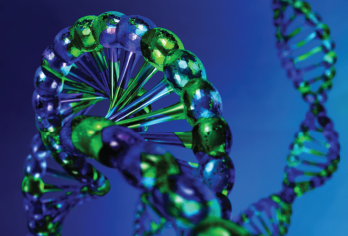
Somatic mosaicism refers to the occurrence of two genetically distinct populations of cells within an individual, derived from a postzygotic mutation.
ustas7777777/shutterstock.com
New methods of gene sequencing have resulted in improved identification of mutations in patients and increased availability of genetic testing in rare diseases. Despite these exciting advances, a majority of patients lack identifiable mutations and the underlying disease etiology remains an enigma. Somatic mosaicism (SM) may be an explanation for some of these clinically challenging patients.
“The concept of SM is actually a bit odd when you think about it,” said Hal Hoffman, MD, from the University of California, San Diego. “Instead of mutations being passed on from parent to child, or happening in the sperm or egg, the mutation occurs as the embryo is developing, or even after birth. What you end up with is an individual that can have different DNA or different mutations in different cells—a genetic smorgasbord.”
Not a New Concept
Somatic mosaicism is not a new concept. It is more easily recognized in the skin, when the mutation affects skin coloring, causing some areas of skin to appear dark in pigmentation and other areas lighter in color.
“In these cases, the mosaicism happens in just one particular type of tissue or cell,” said Dr. Hoffman. “For other patients, it can occur in a subset of those cells and span a number of tissues, often leading to larger effects.”
This variability in expression can complicate genetic diagnosis of diseases. For example, if the tissue sampled for genetic testing, typically blood or saliva, is not expressing the mutation, a patient may appear to not carry the mutation: the equivalent of a false negative.
SM Can Occur at Any Age
Further complicating genetics, SM mutations may occur at any age. Therefore, an individual appearing to have late-onset disease may have simply had too few cells expressing the mutation in early life to generate symptoms.
Although not often discussed, mosaicism is not a novel concept to immunologists and is an important characteristic of an effective immune system. Somatic rearrangement results in the normal diversity of immunoglobulin and T cell receptor genes, necessary for keeping individuals safe from ever-evolving infections.
However, SM has key detrimental aspects, as well, and has long been recognized in cancer with daughter cells genetically different from each other and from host cells. More recently, researchers have begun to recognize the implications of SM in autoinflammatory syndromes.
Reason for Atypical Presentations?
In the already rare autoinflammatory syndromes, SM may result in atypical presentations of diseases. In addition, the rarity of the mutant cells in some patients makes it easy to miss these infrequent changes using current genetic testing technologies. Further complicating diagnosis is the fact that these mutations can happen later in life, so patients may not show symptoms until middle age or beyond.

